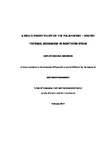A multi-proxy study of the Palaeocene - Eocene Thermal Maximum in northern Spain
| dc.contributor.supervisor | Grimes, Stephen Thomas | |
| dc.contributor.author | Manners, Hayley Rachael | |
| dc.contributor.other | School of Geography, Earth and Environmental Science | en_US |
| dc.date.accessioned | 2014-02-25T11:15:33Z | |
| dc.date.available | 2014-02-25T11:15:33Z | |
| dc.date.issued | 2014 | |
| dc.identifier | 10063591 | en_US |
| dc.identifier.uri | http://hdl.handle.net/10026.1/2895 | |
| dc.description.abstract |
At the boundary between the Paleocene and Eocene epochs (ca. 56 Ma) a significant global warming event, termed the Paleocene-Eocene Thermal Maximum (PETM), occurred. Records of this event are characterised by a negative carbon isotope excursion (CIE) which has been associated with the release of thousands of petagrams of isotopically light carbon into the ocean-atmosphere system, initiating changes in the carbon cycle, the climate system, ocean chemistry and the marine and continental ecosystems. The amount of isotopically light carbon that was required to cause the event, its source and the rapidity of its release are, however, are still debated. This study uses δ13CTOC, δ13Cn-alkane, δ13CCARB and palynological data to evaluate the PETM CIE in terms of the magnitude of the CIE in both continental and marine settings, rapidity of release and drawdown of carbon, and mobilisation of different organic matter (OM) pools as a response to the climate change. The sections studied span a continental to marine transect in northern Spain. This represents the first organic geochemical study of these PETM sections, one of the first comparisons of CIE magnitude between continental and marine sections within the same sediment routing system, and one of the first comparisons of the same OM proxies within different depositional environments. The data suggest that different OM pools were mobilised in response to the PETM, with reworking of older material, soil residence times, and contemporaneous vegetation all contributing. CIE profile shapes predominantly suggest a rapid onset and recovery from the event. The magnitude of the CIE was also assessed. The current resolution of the data suggests that the differences between continental and marine CIE magnitudes could be minimal within a single sediment routing system, perhaps establishing a realistic CIE magnitude for the PETM, for use in future modelling scenarios. | en_US |
| dc.description.sponsorship | University of Plymouth | en_US |
| dc.language.iso | en | en_US |
| dc.publisher | University of Plymouth | en_US |
| dc.subject | PETM | en_US |
| dc.subject | Organic Geochemistry | en_US |
| dc.subject | Palaeoclimate | en_US |
| dc.subject | Spain | en_US |
| dc.title | A multi-proxy study of the Palaeocene - Eocene Thermal Maximum in northern Spain | en_US |
| dc.type | Thesis | |
| plymouth.version | Full version | en_US |
| dc.identifier.doi | http://dx.doi.org/10.24382/4802 |
Files in this item
This item appears in the following Collection(s)
-
01 Research Theses Main Collection
Research Theses Main


